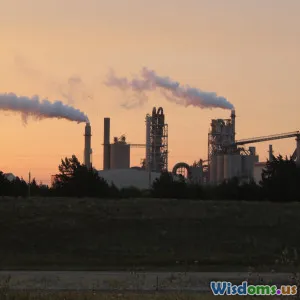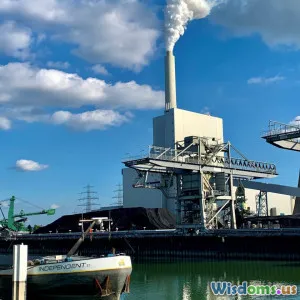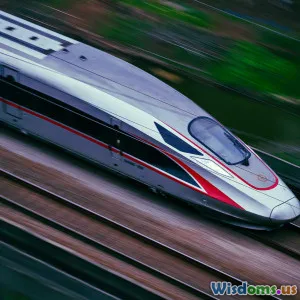
How High Speed Rail Reduces Urban Air Pollution
13 min read Discover how high-speed rail transforms cities by reducing urban air pollution, cutting car dependency, and paving the way for sustainable, livable urban environments. (0 Reviews)
How High Speed Rail Reduces Urban Air Pollution
Cities across the globe hum with movement, but in that dynamic energy, a silent threat lurks: air pollution. In metropolises crowded with cars and choking on their own emissions, a transformative solution is speeding down the tracks. High-speed rail (HSR), celebrated for its unmatched velocity, is also emerging as a frontline fighter against urban air pollution. But how, exactly, does this mode of transport reshape our skies—and our health?
Introduction: Racing Against Pollution
Imagine a city where the morning commute glides through sleek, electric trains rather than bumper-to-bumper traffic. Picture urban air unclouded by exhaust, where children breathe easier and blue horizons beckon. While cars and buses stall on congested streets, HSR whooshes past at over 200 mph on dedicated tracks, powered by electricity and innovation.
Worldwide, leaders are betting big on HSR not only for speed but also as a keystone of planetary health. As cities reckon with gridlock and smog, understanding the true ecological and social impacts of HSR becomes urgent―for politicians, citizens, and the planet alike.
The Urban Air Quality Crisis
Facts and Consequences
Traffic-related air pollution is one of the principal environmental health threats in urban areas. According to the World Health Organization (WHO), 99% of the worldwide urban population breathes air that exceeds recommended pollution limits.[1] Major pollutants include particulate matter (PM2.5 and PM10), nitrogen oxides (NOx), carbon monoxide (CO), and volatile organic compounds (VOCs). These are largely attributed to internal combustion vehicles forming commuting convoys through city centers.
The Health Toll
- Globally, air pollution causes 7 million premature deaths each year, the vast majority in cities[2].
- In the United States, transportation is now the single largest source of greenhouse gas emissions—28% of the national total, per the EPA.
City dwellers suffer higher rates of asthma, cardiovascular diseases, and even cognitive decline, with traffic emissions often to blame.
Congestion and Its Cascading Effects
It's not just what's coming out of tailpipes. Traffic congestion also leads to:
- Increased idling and start-stop driving (amplifying emissions);
- Urban Heat Islands (worsening ozone formation);
- Reduced urban livability (as residents avoid walking and cycling).
Facing this interconnected web of problems, high speed rail offers a compelling alternative.
HSR: Clean, Fast, and Transformative
Understanding High Speed Rail
High-speed rail refers to electric trains capable of sustained speeds above 155 mph (250 km/h), often on tracks separate from conventional rail networks.[3] Famous examples include France’s TGV, Japan’s Shinkansen, and China’s sprawling HSR network—the largest in the world.
Crucially, HSR is typically electricity-powered, making it far cleaner than diesel trains, automobiles, or planes per passenger-kilometer.
The Key Mechanisms: Why HSR Reduces Urban Air Pollution
Let's break down how HSR tangibly improves air quality in and around cities:
1. Displacing Car and Plane Trips
A core benefit of HSR is modal shift—convincing travelers to choose trains instead of more polluting modes.
- Fewer cars on the road: Each HSR train can carry hundreds of passengers, removing dozens if not hundreds of cars from city streets.
- Plane flight substitution: HSR is highly competitive for journeys between 100–600 miles. At these distances, taking the train is as fast—door-to-door—as flying, especially when airports are distant and involve long check-in times. This switch is significant: short-haul flights are among the most polluting transportation modes per mile.
Example:
After Spain built its Madrid-Barcelona AVE HSR line, the share of travelers flying between the two cities dropped from 90% to under 30%, while train trips soared—eliminating more than 60,000 plane journeys per month.[4]
2. Cleaner Energy Sources
HSR's environmental benefit depends largely on how its electricity is generated. In places where the grid is decarbonizing, HSR’s emissions footprint drops further. Many HSR systems—and an increasing number—are actively powered by renewable energy.
- France's TGV system uses close to 90% nuclear electricity, almost eliminating CO2 emissions per trip.
- In California, the under-construction high-speed rail has pledged to run solely on renewable energy.[5]
This compares to conventional cars, where—even in the best case—emissions only decrease as electric vehicle use becomes mainstream.
3. Relieving Congestion in Urban Cores
By offering attractive intercity connections, HSR systems encourage people to arrive and circulate in cities via mass transit—not with private vehicles. Many HSR stations are major multimodal hubs, where travelers transfer easily to metros, trams, or buses.
In effect, HSR can:
- Reduce rush-hour congestion
- Lower traffic jams at urban entry points
- Free urban roads for necessary local traffic, biking, and walking
4. Encouraging Walkable Communities
HSR station-centered development (transit-oriented development) sparks denser, more walkable city districts. Instead of vast parking garages and highways, new neighborhoods often flourish around the stations—encouraging active transport rather than car dependence.
Real-World Evidence: Global Case Studies
Tokyo and Japan’s Shinkansen
Japan pioneered high-speed rail in 1964 with the Shinkansen. Not only did it create space-age travel, but it also drastically altered commuting habits in Japanese megacities.
Quote: “The Shinkansen allowed for efficient commuter movement that reshaped our daily lives, with no direct emissions on Tokyo streets.” — Masayuki Kusakabe, professor, Tokyo Institute of Technology
Today, over 400 million passengers annually opt for electric HSR over car or regional aviation—the carbon savings are immense.
France’s TGV and Urban Clean Air
By shifting high numbers of travelers from highways and airports, the TGV (Train à Grande Vitesse) network slashed road congestion. A French government study found that every TGV journey between Paris and Lyon saves the equivalent emissions of 4,000 cars annually.[6]
China: The World’s Largest HSR System
Since 2008, China has laid over 25,000 miles of HSR track. Forbes estimates that—as a result—China has reduced its annual greenhouse gas emissions by 13 million tons CO2-equivalent[7].
Urban Impact: As intercity travelers move by train instead of by car or bus, Chinese city centers like Beijing and Shanghai have recorded downward trends in NOx and PM2.5 concentrations near major rail corridors.[8]
U.S. Potential: Making the Case
California’s high-speed rail project, though still in construction, has set ambitious goals:
- 100% renewable-powered trains
- Emissions reductions equivalent to taking 400,000 cars off the road annually by 2040
- Improved air quality in some of the most polluted parts of the state, including the Central Valley[9]
High Speed Rail Versus Other Emission Reduction Strategies
HSR isn’t a silver bullet, but it complements a broader arsenal:
- Public Transit Upgrades (metros, buses): Excellent for shorter urban trips but less effective for city-to-city travel
- Cycling and pedestrianization: Best for intra-city mobility, not for medium-distance journeys
- Electric Cars: Important, but their environmental gains depend on clean electricity. They also add to congestion and land use challenges if not paired with modal shift.
HSR is most powerful when fully integrated with local clean transport networks and supportive city planning.
Addressing Concerns: Are There Drawbacks?
No solution comes without questions. HSR is expensive and requires significant construction, raising concerns about carbon footprint, land use, and equity.
Construction Emissions
Building tracks, viaducts, and stations is energy-intensive. If built carelessly, the up-front "embedded" emissions could offset near-term gains. However, research shows that HSR’s lifetime carbon savings outweigh construction emissions within years of operation – especially when powered by renewables[10].
Land Use and Urban Sprawl
Without smart planning, HSR stations on urban fringes could drive sprawl. The challenge: place stations in city centers and integrate with transit to maximize environmental benefits.
Equitable Accessibility
Tickets need to be affordable, and planning must ensure that all city residents, not just the wealthy, benefit from cleaner air and fast connections.
The Future: Reimagining Cities With HSR
Imagine global cities with verdant “green scars” replacing congested highways, mopeds replaced by pedestrian plazas, and train arrivals woven seamlessly into daily life. High-speed rail isn’t just about slick trains—it’s a catalyst for cultural, spatial, and public health shifts.
Inspirational Example: In Spain, cities like Zaragoza and Málaga have used new HSR hubs as blueprints for urban green districts. With reduced car dependency, air quality indices have demonstrated consistent improvement since the arrival of HSR stations.[11]
What Can Citizens and Policymakers Do?
Citizens:
- Advocate for electrified rail expansions in your city or state.
- Choose train travel for medium-distance journeys whenever possible.
- Support local transit connectivity to and from HSR stations.
Policymakers:
- Invest boldly, not only in high speed track but in “last mile” links (trams, shuttles, or bikeways) to stations.
- Mandate renewable energy purchases for all-electric rail networks.
- Design city plans that invite dense, lively HSR hub development instead of car-centric sprawl.
Conclusion: Seizing the Clean Air Opportunity
High-speed rail is more than a feat of engineering; it is a paradigm shift for urban sustainability. By displacing polluting vehicles, slashing the need for short-haul flights, and creating new urban forms geared around active, clean mobility, HSR holds out hope for healthier skies above the world’s cities.
If our future urban landscapes are to be vibrant, healthy, and livable, then high speed trains must be an essential engine in the fight against air pollution. For travelers, leaders, and the coming generations, those trains can’t arrive fast enough.
Citations
- World Health Organization: Urban air pollution
- WHO Air Quality and Health Fact Sheet
- International Union of Railways (UIC): High-Speed Rail
- European Environment Agency: Rail and aviation modal split
- California High-Speed Rail Authority: Sustainability
- French Ministry for the Ecological Transition: TGV Environmental Impact Report
- Forbes: How China's High-Speed Rail Cuts Emissions
- Nature Communications: "High-speed rail, city development and air pollution in China" (2022)
- California HSR Authority: Air Quality Fact Sheet
- International Transport Forum: High-Speed Rail and Sustainability
- European Union Regional and Urban Policy: "HSR impacts on urban environments in Spain" (2020)
Rate the Post
User Reviews
Popular Posts




















